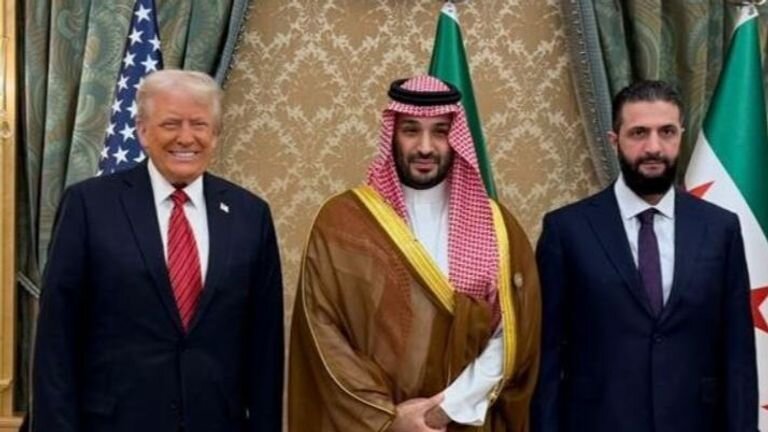London – Trump’s visit to the Middle East ended with astronomical investment commitments ($3-4 trillion) mainly from Saudi Arabia, Qatar and the UAE. Sealed with epic ritual events, these deals reflect what could be described as an unprecedented, extraordinary display of political submission, than Trump had dreamed of.
Given that US GDP is around $27 trillion, these agreements represent almost 15% of that figure, showing Trump’s business-centric approach.
Trump sees himself as a global figure, not only a leader of the nation. His vision for America includes reaffirming its control through economic leverage. This is evident in his strategy of raising tariffs to encourage domestic manufacturing, thereby reducing reliance on imports.
The weaker dollars Trump has supported is consistent with its goal of increasing the competitiveness of US exports worldwide and positioning the US as a major exporter. Without a strong economic foundation, he believes that the global impact of the US would be unsustainable, particularly taking into account the rise of China. For Trump, economic strength must support America’s geopolitical power.
During the trip, major deals involving Boeing aircraft, the US Defense Systems and technical agreements were hit. These moves are designed to stimulate the domestic defense industry, create thousands of jobs and reestablish America as a manufacturing hub. Trump visited U.S. Air Force Base in Aldeid, Qatar, reaffirmed his commitment to maintaining military facilities only in locations of strategic importance as a foreign military strategy.
Trump opposed the vast funding for hidden operations often associated with NGOs or deep states, and cut down USAID when he first took office. Trump’s “America First” slogan leads to prioritizing internal economic strength while exploiting global influences by imposing orders.
In a controversial move, Trump effectively met Syrian President Alshara. Alshara is a person with history tied to al-Qaeda, who claimed that the deep American states were on their side in Syria. Assad’s overthrow came from a deep state before Trump came to power, so he did not withdraw from the region while Syria remained within the axis of resistance.
Trump had previously denounced such groups on the terrorism list, but he appeared to overlook Alshara’s past, in addition to assuming power without elections and establishing Congress outside the legal framework.
The meeting takes place in the context of the ultimate obedience and fulfillment of American demands. In exchange, Al-Sharaa’s leadership promotes normalization with Israeli entities and implements US security needs. The secret services of Israeli professional organizations were already directly involved in interrogating Palestinian leaders, such as Talal Naj.
Trump’s involvement shows a de facto recognition of new Syrian leadership in line with American interests. He prefers the Syrian government supported by the Persian Gulf Arab countries over those influenced by Türkiye. But by the time he took office, Syria’s political outcome had already been shaped.
The most important aspect of Trump’s trip regarding Syria was to give Saudi Arabia the role of sponsoring Syrian files away from Qatar. Therefore, the sponsorship of the Syrian file is within the balance of interests between the Turkish, Saudi Arabia and Israeli occupational organizations, and regional leadership will be passed on to Mohammed bin Salman. This is ready to shape the future of Syria, but this has not yet been decided and can go in any direction.
Despite Saudi Arabia’s concerns over the gains of power of former al-Qaeda groups in Syria, the Kingdom’s sponsorship highlights that these groups serve functional Western interests, due to a potential threat to their own stability. Whether Muslims or associated with the Muslim Brotherhood, the motivations of groups like Hayat Taharil al-Sham seem more power-driven than ideology.
The Syrian government remains unstable today, serving as a tool for foreign interests rather than sovereign entities. Its internal divisions, conflicting agendas, and reliance on external sponsors increases differences, making them more reliable and difficult to control. Western sanctions are lifted as concessions drawn through submissions rather than insurmountable, intensive perceptions of Syria.
Trump’s tour of the Middle East helped to clarify the expansion of regional roles and strategic integrity of the Persian Gulf Arab countries. Syria’s fate is now linked to the wider regional landscape, shaped by the influence of Saudi Arabia and Turkish, and further complicated by the uncertain role of Israeli occupation groups.
In the face of strengthening the Persian Gulf and weakening Israeli professional organizations in the face of failing to achieve its goals, the resistance is recognized as a permanent actor that must be negotiated without being ignored.
Trump has admitted America’s defeat in the face of Yemen’s courage, and the issue of Gaza remains unresolved, and despite Trump showing positive signs of its potential, a nuclear deal with Iran has yet to be achieved. Essentially, Trump’s visit highlights a new regional order that is economically driven, strategically calculated and reflected, reflecting changes in the power dynamics of West Asia.

